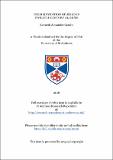Files in this item
The reinvention of jihād in twelfth-century al-Shām
Item metadata
| dc.contributor.advisor | Stewart, Angus Donal | |
| dc.contributor.author | Goudie, Kenneth Alexander | |
| dc.coverage.spatial | x, 226 p. | en_US |
| dc.date.accessioned | 2017-11-07T13:14:24Z | |
| dc.date.available | 2017-11-07T13:14:24Z | |
| dc.date.issued | 2016-11-30 | |
| dc.identifier.uri | https://hdl.handle.net/10023/12019 | |
| dc.description.abstract | This thesis examines the reinvention of jihād ideology in twelfth‑century al‑Shām. In modern scholarship there is a tendency to speak of a revival of jihād in the twelfth century, but discussion of this revival has been dominated by study of the practice of jihād rather than of the ideology of jihād. This thesis addresses this imbalance by studying two twelfth‑century Damascene works: the Kitāb al‑jihād (Book of Jihād) of ʿAlī b. Ṭāhir al‑Sulamī (d. 500/1106), and the al‑Arbaʿūn ḥadīthan fī al‑ḥathth ʿala al‑jihād (Forty Hadiths for Inciting Jihād) of Abū al‑Qāsim Ibn ʿAsākir (d. 571/1176). Through discussion of these texts, this thesis sheds light on twelfth‑century perceptions of jihād by asking what their authors meant when they referred to jihād, and how their perceptions of jihād related to the broader Islamic discourse on jihād. A holistic approach is taken to these works; they are discussed not only in the context of the 'master narrative' of jihād, wherein juristic sources have been privileged over other non‑legal genres and corpora, but also in the context of the Sufi discourse of jihād al‑nafs, and the earliest traditions on jihād which thrived from the eighth century onwards on the Muslim‑Byzantine frontier. This thesis argues that both al‑Sulamī and Ibn ʿAsākir integrated elements from these different traditions of jihād in order to create models of jihād suited to their own political contexts, and that it is only in the context of a more nuanced appreciation of jihād ideology that their attempts can be properly understood. At the same time, this thesis argues against the model of the 'counter‑crusade', which holds that the revival of jihād began in earnest only in the middle of the twelfth century, by stressing that there was no delay between the arrival of the Franks and attempts to modify jihād ideology. | en_US |
| dc.language.iso | en | en_US |
| dc.publisher | University of St Andrews | |
| dc.subject | Crusading | en_US |
| dc.subject | al-Sulamī, ʿAlī b. Ṭāhir | en_US |
| dc.subject | Jihād | en_US |
| dc.subject | Jihād al-nafs | en_US |
| dc.subject | Ibn al-Mubārak, ʿAbd Allāh | en_US |
| dc.subject | Ibn ʿAsākir, Abū al-Qāsim | en_US |
| dc.subject | Counter-crusade | en_US |
| dc.subject | al-Shām | en_US |
| dc.subject | Damascus | en_US |
| dc.subject.lcc | DS97.3G78 | |
| dc.subject.lcsh | Jihad--Syria--History--To 1500 | en |
| dc.subject.lcsh | al-Sulamī, ʻAlī Ibn Ṭāhir, ?-1106/07. Kitāb al‑jihād | |
| dc.subject.lcsh | Ibn ʻAsākir, ʻAlī ibn al-Ḥasan, 1105-1176. Arbaʻūn ḥadīthan fī al-ḥathth ʻalá al-jihād | |
| dc.title | The reinvention of jihād in twelfth-century al-Shām | en_US |
| dc.type | Thesis | en_US |
| dc.contributor.sponsor | Carnegie Trust for the Universities of Scotland | en_US |
| dc.contributor.sponsor | University of St Andrews. School of History | en_US |
| dc.type.qualificationlevel | Doctoral | en_US |
| dc.type.qualificationname | PhD Doctor of Philosophy | en_US |
| dc.publisher.institution | The University of St Andrews | en_US |
This item appears in the following Collection(s)
Items in the St Andrews Research Repository are protected by copyright, with all rights reserved, unless otherwise indicated.

